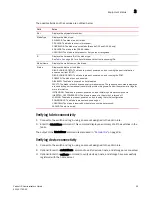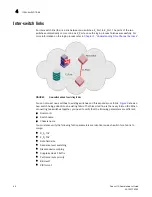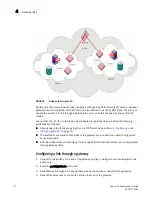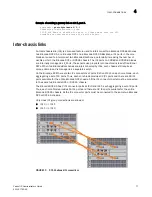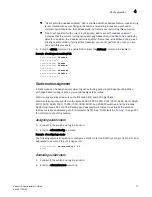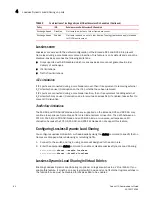
Fabric OS Administrator’s Guide
67
53-1001763-02
Inter-switch links
4
There are non-fabric parameters that must match as well, such as zoning. Some fabric services,
such as Management Server must match. If it is enabled in the fabric, then the switch you are
introducing into the fabric must also have it enabled. If you experience a segmented fabric, refer to
the
Fabric OS Troubleshooting and Diagnostics Guide
to fix the problem.
Buffer credits
In order to prevent the dropping of frames in the fabric, a device can never send frames without the
receiving device being able to receive them, so an end-to-end flow control is used on the switch.
Flow control in Fibre Channel uses buffer-to-buffer credits which are distributed by the switch.
When all buffer-to-buffer credits are utilized, a device will wait for a VC_RDY or an R_RDY primitive
from the destination switch before resuming I/O. The primitive is dependent on whether you have
R_RDYs enabled on your switch using the portCfgISLMode command. When a device logs into a
fabric, it typically requests anywhere from two to sixteen buffer credits from the switch, depending
on device type, driver version, and configuration. This determines the maximum number of frames
the port may transmit before receiving an acknowledgement from the receiving device.
For more information on how to set the buffer-to-buffer credits on an extended link, refer to
Chapter
20, “Managing Long Distance Fabrics”
.
Virtual Channels
Virtual channels create multiple logical data paths across a single physical link or connection. They
are allocated their own network resources such as queues and buffer-to-buffer credits. Virtual
channel technology is the fundamental building block used to construct Adaptive Networking
services. For more information on Adaptive Networking services, refer to
Chapter 18, “Optimizing
Fabric Behavior”
.
Virtual channels are divided into three priority groups. P1 is the highest which is used for Class F,
F_RJT, and ACK traffic. P2 is the next highest which is used for data frames. The data virtual
channels can be further prioritized to provide higher levels of Quality of Service. P3 is the lowest
and is used for broadcast and multicast traffic.
Summary of Contents for 53-1001763-02
Page 1: ...53 1001763 02 13 September 2010 Fabric OS Administrator s Guide Supporting Fabric OS v6 4 0 ...
Page 4: ...iv Fabric OS Administrator s Guide 53 1001763 02 ...
Page 24: ...xxiv Fabric OS Administrator s Guide 53 1001763 02 ...
Page 28: ...xxviii Fabric OS Administrator s Guide 53 1001763 02 ...
Page 32: ...xxxii Fabric OS Administrator s Guide 53 1001763 02 ...
Page 40: ...xl Fabric OS Administrator s Guide 53 1001763 02 ...
Page 42: ...2 Fabric OS Administrator s Guide 53 1001763 02 ...
Page 54: ...14 Fabric OS Administrator s Guide 53 1001763 02 High availability of daemon processes 1 ...
Page 74: ...34 Fabric OS Administrator s Guide 53 1001763 02 Basic connections 2 ...
Page 102: ...62 Fabric OS Administrator s Guide 53 1001763 02 Audit log configuration 3 ...
Page 214: ...174 Fabric OS Administrator s Guide 53 1001763 02 Management interface security 7 ...
Page 228: ...188 Fabric OS Administrator s Guide 53 1001763 02 Brocade configuration form 8 ...
Page 276: ...236 Fabric OS Administrator s Guide 53 1001763 02 Creating a logical fabric using XISLs 10 ...
Page 404: ...364 Fabric OS Administrator s Guide 53 1001763 02 ...
Page 440: ...400 Fabric OS Administrator s Guide 53 1001763 02 Performance data collection 17 ...
Page 480: ...440 Fabric OS Administrator s Guide 53 1001763 02 F_Port masterless trunking 19 ...
Page 494: ...454 Fabric OS Administrator s Guide 53 1001763 02 Buffer credit recovery 20 ...
Page 574: ...534 Fabric OS Administrator s Guide 53 1001763 02 Hexadecimal overview E ...



